|
|
|
|
|
Oil On
Canvas, Real Flavor of Old Masters
|
|

|
ARTWORKS
INDEX
A B C D E F G H I J K L M N O P Q R S T U V W X Y Z |
ARTISTS
INDEX
A B C D E F G H I J K L M N O P Q R S T U V W X Y Z |
|
|
| | |
|
|
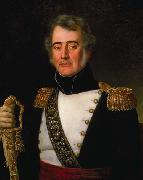 |
Jean joseph Taillasson -- Click Here
|
|
French Painter , Bordeaux 1745-1809 Paris
was a French history painter and portraitist, draftsman and art critic, who matured his talent in the Paris ateliers of Joseph-Marie Vien (from 1764) and Nicolas Bernard L??pici?? and, having won third place in the Prix de Rome competition, 1769, spent four years, 1773-77, in Italy. At his return to Paris he set an early example of neoclassicism. His Observations sur quelques grands peintres, (Paris, Duminil-Lesueur) 1807, offered anti-academic advice somewhat at variance with his own manner |
|
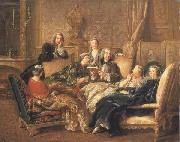 |
Jean Francois de troy -- Click Here
|
|
French Neoclassical Painter, 1679-1752
was a French Rococo painter and tapestry designer. He was one of a family of painters, being the son of the portrait painter François de Troy (1645-1730), under whom he first studied, and at whose expense he went to Italy 1699-1706, staying in Rome, but also visiting many north Italian cities. Jean François de Troy was born on January 27, 1679 in Paris. The successful career of Jean François de Troy was based initially on large historical and allegorical compositions, such as Time Unveiling Truth (1733) in the National Gallery, London, but he is now most highly regarded for his smaller and more spirited scenes of elegant social life. They are among the best of those that rode on the wave of Watteau's success indeed The Alarm, or the Gouvernante Fidele (Victoria and Albert Museum, London, 1723) was attributed to Watteau in the 19th century. A versatile artist, he made tableaux de modes famous, painting histories and mythologies in a colourful and fluent manner which owed something to both Veronese and Peter Paul Rubens. He undertook commissions for Versailles and Fontainebleau between 1724 and 1737, and designed two sets of tapestries for the Gobelins, each of seven subjects, the Histoire d'Esther (1737-40) and the Histoire de Jason (1743-6). |
|
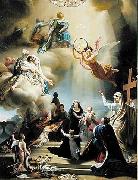 |
Jean Charles Tardieu -- Click Here
|
|
French Painter, 1765-1830 |
|
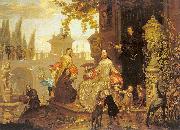 |
Jan Van Kessel the Younger -- Click Here
|
|
1654-1708
Dutch
Jan Van Kessel Gallery |
|
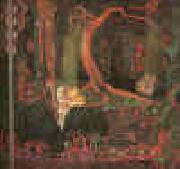 |
Jan Toorop -- Click Here
|
|
1858-1928
Dutch Jan Toorop Gallery
He moved to the Netherlands in 1872 and took a course in drawing at the Polytechnische School in Delft (1876-9). He also studied at the Rijksakademie voor Beeldende Kunsten in Amsterdam (1880-82) and at the Ecole des Arts D?coratifs in Brussels (1882-5). In Amsterdam he joined the St Lukas Society, and in Belgium he was a founder-member of Les XX in 1884. Although he had met Jozef Isra?ls in 1880 and respected the style of the Hague school, he was more attracted by what he saw in Brussels, particularly work by French artists. His portraits of 1884 are painted in an Impressionist style. With other members of Les XX he trained himself in plein-air; he learnt from James Ensor how to apply colours with a palette knife and how to use white with the same intensity as other colours. His style, however, remained austere and his scenes of workmen show a sensitive realism reminiscent of Gustave Courbet's work, for example Respect for the Dead. |
|
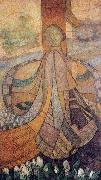 |
Jan Thorn-Prikker -- Click Here
|
|
(June 5, 1868, The Hague - March 5, 1932, Cologne) was a Dutch painter and designer in the Art Nouveau style. He was an important figure in religious art, best known for his stained glass windows. His most famous painting is the mystical The Bride (1893), in the Kroller-Muller Museum, Otterlo.
|
|
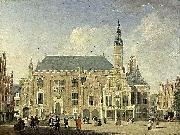 |
Jan ten Compe -- Click Here
|
|
painted view of the Town Hall in 18th century
|
|
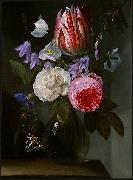 |
Jan Philip van Thielen -- Click Here
|
|
(Mechelen, 1618 - Mechelin, 1667) was a Flemish Baroque painter who specialized in flowers.
Van Thielen was the son of a minor nobleman and eventually assumed the title of Lord of Couwenberch. In 1631 or 1632 he began studying at the age of thirteen with his future brother-in-law, the history painter Theodoor Rombouts (1597-1637), and in 1641 he commenced his studies with the flower painter Daniel Seghers (1590-1661). According to Houbraken (who mistakenly wrote his birth year as 1681 instead of 1618), his reputation during his lifetime was such that he received patronage from the Spanish crown, |
|
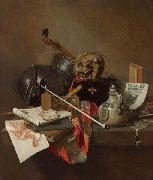 |
Jan Jansz. Treck -- Click Here
|
|
(1606, Amsterdam, 25 September 1652 ) was a still-life painter during the Dutch Golden Age. Treck used economy in the number of his objects.
In 1623 Treck was trained for half a year by Jan den Uyl, who had married his sister Geertruid in 1619. His style also shows influence by Pieter Claesz and Willem Heda. In 1643 and 1644 Treck was trained by Abraham Jansz for 4 guilders a week, but forgot to pay for his apprenticeship. He also had to pay for a window that was made to get more light, while working.
His earliest known signed and dated work is from 1641, after the death of Den Uyl. A work has surfaced with both signatures, implying that Treck perhaps finished Den Uyl's paintings after his death. Treck also had helped his brother-in-law to sell his house (on Singel) in 1639. After the death of his friend Abraham, Treck bought his equipment, paint and easel. In 1640 he supplied the art dealer Hendrick Uylenburgh with money.
After Treck's death his brother, sister and his niece and nephews inherited a small house in an alley from Singel to Spuistraat, furniture, clothes, stocks, coins, jewelry, prints and paintings. In 1661 Simon Luttichuys was asked to repaint a vanitas done by Treck.
Treck influenced Pieter van Anraedt and Willem Kalf. |
|
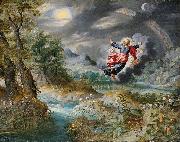 |
Jan Brueghel the Younger -- Click Here
|
|
(September 13, 1601 C September 1, 1678) was a Flemish Baroque painter, and the son of Jan Brueghel the Elder.
He was trained by his father and spent his career producing works in a similar style. Along with his brother Ambrosius, he produced landscapes, allegorical scenes and other works of meticulous detail. Brueghel also copied works by his father and sold them with his father's signature. His work is distinguishable from that of his parent by being less well executed and lighter.
Jan the Younger was traveling in Italy when his father died of cholera and swiftly returned to take control of the Antwerp studio. He soon established himself and was made dean of the Guild of Saint Luke in 1630. That same year he was commissioned by the French court to paint Adam Cycle. In the following years, he also produced paintings for the Austrian court, and worked independently in Paris, before returning to Antwerp in 1657. He collaborated with a number of prominent artists including Rubens, Hendrick van Balen (1575-1632), Adriaen Stalbemt (1580-1682), Lucas Van Uden (1596-1672), David Teniers the Younger and his father-in-law Janssen. Jan the Younger's best works are his extensive landscapes, either under his own name or made for other artists such as Hendrick van Balen as backgrounds.
|
|
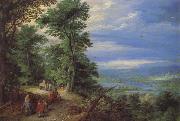 |
Jan Brueghel The Elder -- Click Here
|
|
Flemish Baroque Era Painter, 1568-1625
was a Flemish painter, son of Pieter Brueghel the Elder and father of Jan Brueghel the Younger. Nicknamed "Velvet" Brueghel, "Flower" Brueghel, and "Paradise" Brueghel, of which the latter two were derived from favored subjects, while the former may refer to the velveteen sheen of his colors or to his habit of wearing velvet. He was born in Brussels. His father died in 1569, and then, following the death of his mother in 1578, Jan, along with his brother Pieter Brueghel the Younger ("Hell Brueghel") and sister Marie, went to live with their grandmother Mayken Verhulst (widow of Pieter Coecke van Aelst). She was an artist in her own right, and according to Carel van Mander, possibly the first teacher of the two sons. The family moved to Antwerp sometime after 1578. He first applied himself to painting flowers and fruits, and afterwards acquired considerable reputation by his landscapes and sea-pieces. He formed a style more independent of his father's than did his brother Pieter the Younger. His early works are often landscapes containing scenes from scripture, particularly forest landscapes betraying the influence of the master forest landscape-painter Gillis van Coninxloo. Later in his career, he moved toward the painting of pure landscapes and townscapes, and, toward the end, of still lifes. After residing long at Cologne he travelled into Italy, where his landscapes, adorned with small figures, were greatly admired. He left a large number of pictures, chiefly landscapes, which are executed with great skill. Many of his paintings are collaborations in which figures by other painters were placed in landscapes painted by Jan Brueghel. |
|
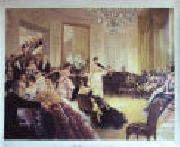 |
James Tissot -- Click Here
|
|
French Painter, 1836-1902
French painter, printmaker and enamellist. He grew up in a port, an experience reflected in his later paintings set on board ship. He moved to Paris c. 1856 and became a pupil of Louis Lamothe and Hippolyte Flandrin. He made his Salon d?but in 1859 and continued to exhibit there successfully until he went to London in 1871. His early paintings exemplify Romantic obsessions with the Middle Ages, while works such as the Meeting of Faust and Marguerite (exh. Salon 1861; Paris. Mus. d'Orsay) and Marguerite at the Ramparts (1861; untraced, see Wentworth, 1984, pl. 8) show the influence of the Belgian painter Baron Henri Leys. In the mid-1860s Tissot abandoned these tendencies in favour of contemporary subjects, sometimes with a humorous intent, as in Two Sisters (exh. Salon 1864; Paris, Louvre) and Beating the Retreat in the Tuileries Gardens (exh. Salon 1868; priv. col., see Wentworth, 1984, pl. 45). The painting Young Ladies Looking at Japanese Objects (exh. Salon 1869; priv. col., see Wentworth, 1984, pl. 59) testifies to his interest in things Oriental, and Picnic (exh. Salon 1869; priv. col., see 1984 exh. cat., fig. 27), in which he delved into the period of the Directoire, is perhaps influenced by the Goncourt brothers. Tissot re-created the atmosphere of the 1790s by dressing his characters in historical costume. |
|
 |
James Joseph Jacques Tissot -- Click Here
|
|
James Jacques Joseph Tissot (15 October 1836 - 8 August 1902) was a French painter, who spent much of his career in Britain.
Tissot was born in Nantes, France. In about 1856, he began study at the École des Beaux-Arts in Paris under Hippolyte Flandrin and Lamothe, and became friendly with Edgar Degas and James Abbott McNeill Whistler. Tissot exhibited in the Paris Salon for the first time in 1859, two portraits of women and three scenes in medieval dress from Faust. The latter show the influence of the Belgian painter Henri Leys (Jan August Hendrik Leys), whom he had met in Antwerp in 1859. In the mid-1860s, however, Tissot began to concentrate on depicting women, often although not always shown in modern dress. Like contemporaries such as Alfred Stevens and Claude Monet, Tissot also explored japonisme, including Japanese objects and costumes in his pictures. A portrait of Tissot by Degas from these years (Metropolitan Museum of Art, New York) shows him with a Japanese screen hanging on the wall. |
|
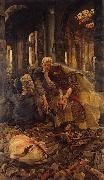 |
James Jacques Joseph Tissot -- Click Here
|
|
(15 October 1836 -- 8 August 1902) was a French painter.
Tissot was born at Nantes. He studied at the École des Beaux-Arts in Paris under Ingres, Flandrin and Lamothe, and exhibited in the Paris Salon for the first time at the age of twenty-three. In 1861 he showed The Meeting of Faust and Marguerite, which was purchased by the state for the Luxembourg Gallery. His first characteristic period made him a painter of the charms of women. Demi-mondaine would be more accurate as a description of the series of studies which he called La Femme a Paris.
|
|
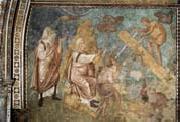 |
Jacopo Torriti -- Click Here
|
|
Italian painter, Roman school active c. 1270-1300, Italian painter and mosaicist. Two mosaics in Rome are signed by him: one, on the apse of S Giovanni in Laterano, that once bore the date 1291 (or, according to some sources, 1290 or 1292); and another on the apse and triumphal arch of S Maria Maggiore, now replaced by a 19th-century restoration but at one time dated 1295 or 1296. Torriti is also known to have executed a mosaic for Arnolfo di Cambio's tomb of Pope Boniface VIII (1296; destr.; see ARNOLFO DI CAMBIO) in Old St Peter's, Rome. Torriti was active during the same period as Cimabue and Giotto, Pietro Cavallini and Arnolfo di Cambio, but his fame has been obscured by theirs, no doubt because of his closer links with Byzantine art. He was nevertheless one of the most important artists working in Rome during the papacy of Nicholas IV (1288-92) and was entrusted with some of the most prestigious commissions of the day. |
|
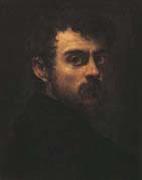 |
Jacopo Tintoretto -- Click Here
|
|
1518-1594
Italian painter. His father was a silk dyer (tintore); hence the nickname Tintoretto ("Little Dyer"). His early influences include Michelangelo and Titian. In Christ and the Adulteress (c. 1545) figures are set in vast spaces in fanciful perspectives, in distinctly Mannerist style. In 1548 he became the centre of attention of artists and literary men in Venice with his St. Mark Freeing the Slave, so rich in structural elements of post-Michelangelo Roman art that it is surprising to learn that he had never visited Rome. By 1555 he was a famous and sought-after painter, with a style marked by quickness of execution, great vivacity of colour, a predilection for variegated perspective, and a dynamic conception of space. In his most important undertaking, the decoration of Venice's Scuola Grande di San Rocco (1564 ?C 88), he exhibited his passionate style and profound religious faith. His technique and vision were wholly personal and constantly evolving. |
|
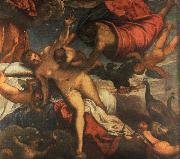 |
Jacopo Robusti Tintoretto -- Click Here
|
|
1518-1594
Italian Tintoretto Galleries
The real name of Tintoretto was Jacopo Robusti, but he is better known by his nickname, meaning the "little dyer, " his father having been a silk dyer. The artist was born in Venice and lived there all his life. Even though his painting is distinguished by great daring, he seems to have led a rather retired life, concerned only with his work and the well-being of his family. His daughter Marietta and his sons Domenico and Marco also became painters, and Domenico eventually took over the direction of Tintoretto's large workshop, turning out reliable but un-inspired pictures in the manner of his father. Some of them are, on occasion, mistaken for works of the elder Tintoretto.
Tintoretto appears to have studied with Bonifazio Veronese or Paris Bordone, but his true master, as of all the great Venetian painters in his succession, was Titian. Tintoretto's work by no means merely reflects the manner of Titian. Instead he builds on Titian's art and brings into play an imagination so fiery and quick that he creates an effect of restlessness which is quite opposed to the staid and majestic certainty of Titian's statements. If Tintoretto's pictures at first sight often astonish by their melodrama, they almost inevitably reveal, at closer observation, a focal point celebrating the wonders of silence and peace. The sensation of this ultimate gentleness, after the first riotous impact, is particularly touching and in essence not different from what we find (although brought about by very different means) in the pictures of Titian and Paolo Veronese.
Tintoretto was primarily a figure painter and delighted in showing his figures in daring foreshortening and expansive poses. His master in this aspect of his art was Michelangelo. Tintoretto is supposed to have inscribed on the wall of his studio the motto: "The drawing of Michelangelo and the color of Titian." Unlike Michelangelo, however, Tintoretto worked and drew very quickly, using only lights and shadows in the modeling of his forms, so that his figures look as if they had gained their plasticity by a kind of magic. In the rendering of large compositions he is reported to have used as models small figures which he made of wax and placed or hung in boxes so cleverly illuminated that the conditions of light and shade in the picture he was painting would be the same as those in the room in which it was to be hung. |
|
|
|
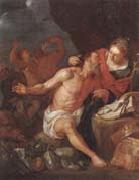 |
Jacob Toorenvliet -- Click Here
|
|
Dutch Baroque Era Painter ,
Leiden circa 1635-1719
|
|
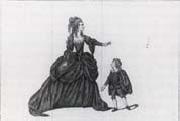 |
J.Thornthwaite -- Click Here
|
|
British.fl.late eighteenth century |
|
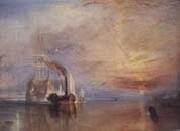 |
J.M.W.Turner -- Click Here
|
|
English Romantic Painter, 1775-1851, British land- and seascape artist. Born in London the son of a barber, Turner was precociously talented. He entered the RA Schools in 1789, had a drawing exhibited at the academy in 1790, and was elected a full academician in 1802. He became professor of perspective in 1807. A prolific artist of amazing range of subject and style, he began work in water-colours, quickly founding both a reputation and a fortune, which made him independent of changing public taste. His work was not appreciated by everyone, but his supporters included Thomas Lawrence, John Ruskin, and the earl of Egremont. He died in eccentric obscurity under a false name. |
|
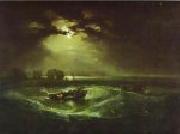 |
J.M.W. Turner -- Click Here
|
|
English Romantic Painter, 1775-1851 landscape master
landscape master .British painter and printmaker. He dominated British landscape painting throughout the first half of the 19th century. He established a reputation in the Royal Academy, London, first as a topographical watercolourist and then within a few years as a painter of Sublime and historical landscapes. |
|
|
|
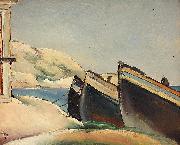 |
Ion Theodorescu Sion -- Click Here
|
|
Ion Theodorescu-Sion (1882-1939).
Alternative names Onu Soare Teodor.
Romanian painter.
|
|
|
|
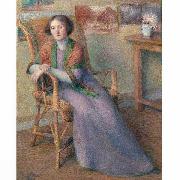 |
Hippolyte Petitjean -- Click Here
|
|
Hippolyte Petitjean (1854 - 1929)
|
|
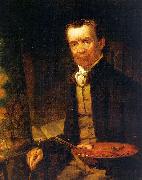 |
Hicks, Thomas -- Click Here
|
|
American Painter, 1823-1890
Cousin of Edward Hicks. After being apprenticed (c. 1835-9) in the sign-painting shop of his cousin, he studied at the Pennsylvania Academy of the Fine Arts in Philadelphia (1839-40) and at the National Academy of Design in New York (1840-44). He then sketched and painted in England, Italy and France before becoming a student of Thomas Couture in Paris (1848-9). On his return to the USA in 1849, he established a studio in New York and quickly became a popular portrait painter, although his portrayals only rarely have enough psychological depth to make them of more than documentary interest. Hamilton Fish (1852; New York, City Hall) is among his stronger works. Hicks also painted genre subjects, such as Musicale: Barber Shop, Trenton Falls (1866; Raleigh, NC Mus. A.), and landscapes, the latter chiefly near Thornwood, his summer residence at Trenton Falls, NY. |
|
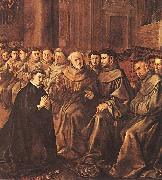 |
HERRERA, Francisco de, the Elder -- Click Here
|
|
Spanish painter (b. ca. 1590, Sevilla, d.
1656, Madrid).
Spanish painter. His early works are in the Mannerist style. Under the influence of Francisco Zurbaron, he developed the naturalistic style seen in his four scenes from the life of St. Bonaventure (1627). About 1650 he moved to Madrid. His last documented work, a painting of St. Joseph (1648) influenced by Anthony Van Dyck, features elongated forms and elaborate draperies. He achieved considerable fame in Sevilla, where Diego Velezquez was briefly his pupil. |
|
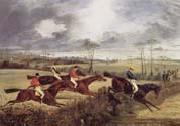 |
Henry Thomas Alken -- Click Here
|
|
1785-1851, Painter and engraver, son of Samuel Alken. He worked in London and the provinces and was prolific in a variety of media while unadventurous in his range of subject-matter. Early instruction by the miniature painter J. T. Beaumont (1774-1851) helped to give a certain graphic precision |
|
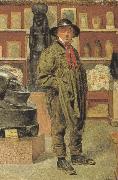 |
Henry stacy marks,R.A. -- Click Here
|
|
1829-1898
English painter. He studied with J. M. Leigh (1808-60) from 1847 and in January 1851 enrolled at the Royal Academy Schools. In 1852 Marks and P. H. Calderon spent five months studying in Paris under Fran?ois-Edouard Picot and at the Ecole des Beaux-Arts. The next year he made his d?but at the Royal Academy Summer Exhibition, where he exhibited annually until 1897. He was elected ARA in 1871 and RA in 1878. |
|
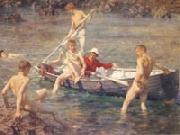 |
Henry Scott Tuke -- Click Here
|
|
British Painter and photographer , 1858-1929
English painter. He entered the Slade School of Art, London, in 1875, under Alphonse Legros and Sir Edward Poynter. In 1877 he won a Slade scholarship and in 1880 travelled to Italy, where he made his first nude life drawings, an important revelation to him of light, colour and the human form. From 1881 to 1883 he was in Paris and met Jules Bastien-Lepage, who encouraged his studies en plein air. |
|
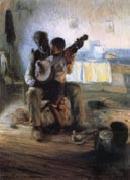 |
Henry Ossawa Tanner -- Click Here
|
|
African-American Realist Painter, 1859-1937
American painter. He was one of the foremost African American artists, achieving an international reputation in the early years of the 20th century for his religious paintings. The son of an African Methodist Episcopal bishop, he studied art with Thomas Eakins from 1880 to 1882 at the Pennsylvania Academy of the Fine Arts in Philadelphia. He then worked in Philadelphia and Atlanta, GA, where he ran a photography studio and taught at Clark College. |
|
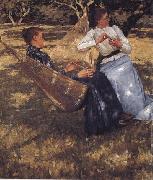 |
Henry Herbert La Thangue -- Click Here
|
|
British painter , 1850-1920 |
|
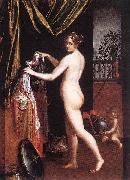 |
Henri Testelin -- Click Here
|
|
(Paris, 1616 - The Hague, 1695) was a French art painter.
Henri Testelin made portraits of Louis XIV, important persons and events at the French court . Several of his paintings can be seen in the palace of Versailles. The portraits, like the one of the young Louis XIV, show the influence of Jean Nocret and Le Brun.
He was secretary of Royal Academy of Painting and Sculpture from 1650 and professor from 1656. In 1680 he published a book on art theory and the academy. Testelin was dismissed from the Academy in 1681, because he was proptestant. He left France and went to Holland.
|
|
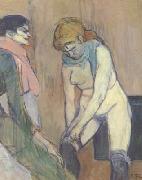 |
Henri de toulouse-lautrec -- Click Here
|
|
1864-1901
French painter and printmaker. He is best known for his portrayals of late 19th-century Parisian life, particularly working-class, cabaret, circus, nightclub and brothel scenes. He was admired then as he is today for his unsentimental evocations of personalities and social mores. While he belonged to no theoretical school, he is sometimes classified as Post-Impressionist. His greatest contemporary impact was his series of 30 posters (1891-1901), |
|
 |
Henri Toulouse-Lautrec -- Click Here
|
|
French Post-Impressionist Painter and Printmaker, 1864-1901
Henri de Toulouse-Lautrec, a direct descendant of the counts of Toulouse, was born on Nov. 24, 1864, at Albi. His eccentric father lived in provincial luxury, hunting with falcons and collecting exotic weapons. Henri began to draw at an early age. He suffered a fall in 1878 and broke one femur; in 1879 he fell again and broke the other one. His legs did not heal properly; his torso developed normally, but his legs were permanently deformed.
Encouraged by his first teachers, the animal painters Rene Princeteau and John Lewis Brown, Toulouse-Lautrec decided in 1882 to devote himself to painting, and that year he left for Paris. Enrolling at the Ecole des Beaux-Arts, he entered the studio of Fernand Cormon. In 1884 Toulouse-Lautrec settled in Montmartre, where he stayed from then on, except for short visits to Spain, where he admired the works of El Greco and Diego Velazquez; Belgium; and England, where he visited Oscar Wilde and James McNeill Whistler. At one point Toulouse-Lautrec lived near Edgar Degas, whom he valued above all other contemporary artists and by whom he was influenced. From 1887 his studio was on the Rue Caulaincourt next to the Goupil printshop, where he could see examples of the Japanese prints of which he was so fond.
Toulouse-Lautrec habitually stayed out most of the night, frequenting the many entertainment spots about Montmartre, especially the Moulin Rouge cabaret, and he drank a great deal. His loose living caught up with him: he suffered a breakdown in 1899, and his mother had him committed to an asylum at Neuilly. He recovered and set to work again. He died on Sept. 9, 1901, at the family estate at Malrome. |
|
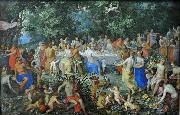 |
Hendrick van Balen the Elder -- Click Here
|
|
painted The Wedding of Thetis and Perseus with Apollo and the Concert of the Muses, or The Feast of the Gods in ca. 1618
|
|
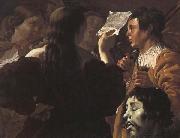 |
Hendrick the Brugghen -- Click Here
|
|
1588-1629
Dutch painter and draughtsman. He was, with Gerrit van Honthorst and Dirck van Baburen, one of the leading painters in the group of artists active in Utrecht in the 1620s who came to be known as the UTRECHT CARAVAGGISTI, since they adapted Caravaggio's subject-matter and style to suit the Dutch taste for religious and secular paintings. Ter Brugghen was an important innovator for later Dutch 17th-century genre painting; his recognition as an unorthodox, |
|
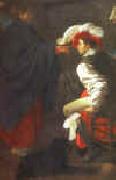 |
Hendrick Terbrugghen -- Click Here
|
|
1588-1629
Dutch Hendrick Terbrugghen Galleries
Dutch painter and draughtsman. He was, with Gerrit van Honthorst and Dirck van Baburen, one of the leading painters in the group of artists active in Utrecht in the 1620s who came to be known as the UTRECHT CARAVAGGISTI, since they adapted Caravaggio subject-matter and style to suit the Dutch taste for religious and secular paintings. Ter Brugghen was an important innovator for later Dutch 17th-century genre painting; his recognition as an unorthodox, but significant influence on the work of Johannes Vermeer and others is a relatively recent, 20th-century phenomenon. |
|
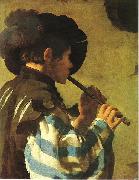 |
Hendrick ter Brugghen -- Click Here
|
|
(1588 - Nov 1, 1629) was a Dutch painter, and a leading member of the Dutch followers of Caravaggio ?? the so-called Dutch Caravaggisti.
Little is known of the early life of ter Brugghen; he could have been born in The Hague, but his family seems to have moved to the strongly Catholic Utrecht in the early 1590s. Here he started painting at the age of thirteen, studying with Abraham Bloemaert. From Bloemaert, a Mannerist history painter, he learned the basics of the art. Around 1604, however, ter Brugghen travelled to Italy to expand his skills, a rather unusual move for Dutch painters at the time. He was in Rome in 1604, and could therefore have been in direct contact with Caravaggio. |
|
 |
Helen Thomas Dranga -- Click Here
|
|
Helen Thomas Dranga (1866-1940), who is also known as Carrie Helen Dranga, was a painter who was born Carrie Helen Tufts in Oxford, England. She lived in Oakland, California from 1894 until 1900, when she moved to Hilo, Hawaii. Her paintings regularly appeared on the cover of Paradise of the Pacific magazine in the 1920s and 1930s. She lived in Hilo until shortly before her death in 1940.
The Honolulu Academy of Arts and the Lyman House Memorial Museum (Hilo, Hawaii) are among the public collections holding works by Helen Thomas Dranga
|
|
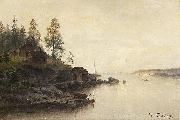 |
Harald Torsslow -- Click Here
|
|
(1838 -1909 ) - Painter
|
|
 |
Hans Thoma -- Click Here
|
|
German Symbolist Painter, 1839-1924
German painter, printmaker and museum director. He was the son of a miller, craftsman and smallholder and studied briefly as a lithographer in Basle in 1854 before being apprenticed to a watchcase painter in Furtwangen. Returning home the same year, he started to draw and paint in his spare time. In 1859 he enrolled at the Kunstschule in Karlsruhe, where he studied until 1866 with Ludwig Des Coudres (1820-78) and the landscape painter Johann Wilhelm Schirmer, by whom he was especially influenced. He spent his summer vacations drawing and painting in Bernau, and his landscapes, portraits and genre pictures from this time record his transition from amateur painter to accomplished artist. His pictures of his mother and his sister Agathe |
|
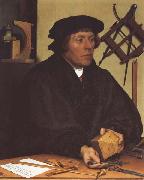 |
Hans holbein the younger -- Click Here
|
|
b. 1497, Augsburg, d. 1543, London
was a German artist and printmaker who worked in a Northern Renaissance style. He is best known as one of the greatest portraitists of the 16th century.[2] He also produced religious art, satire and Reformation propaganda, and made a significant contribution to the history of book design. He is called "the Younger" to distinguish him from his father, Hans Holbein the Elder, an accomplished painter of the Late Gothic school. Born in Augsburg, Holbein worked mainly in Basel as a young artist. At first he painted murals and religious works and designed for stained glass windows and printed books. He also painted the occasional portrait, making his international mark with portraits of the humanist Desiderius Erasmus of Rotterdam. When the Reformation reached Basel, Holbein worked for reformist clients while continuing to serve traditional religious patrons. His Late Gothic style was enriched by artistic trends in Italy, France, and the Netherlands, as well as by Renaissance Humanism. The result was a combined aesthetic uniquely his own. Holbein travelled to England in 1526 in search of work, with a recommendation from Erasmus. He was welcomed into the humanist circle of Thomas More, where he quickly built a high reputation. After returning to Basel for four years, he resumed his career in England in 1532. This time he worked for the twin founts of patronage, Anne Boleyn and Thomas Cromwell. By 1535, he was King's Painter to King Henry VIII. In this role, he produced not only portraits and festive decorations but designs for jewellery, plate, and other precious objects. His portraits of the royal family and nobles are a vivid record of a brilliant court in the momentous years when Henry was asserting his supremacy over the English church. Holbein's art was prized from early in his career. The French poet and reformer Nicholas Bourbon dubbed him "the Apelles of our time".[3] Holbein has also been described as a great "one-off" of art history, since he founded no school.[4] After his death, some of his work was lost, but much was collected, and by the 19th century, Holbein was recognised among the great portrait masters. Recent exhibitions have also highlighted his versatility. |
|
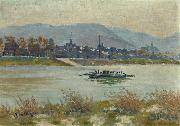 |
Gottfried Trimborn -- Click Here
|
|
painted Rheinfahre in 1920 |
|
 |
Giuseppe Maria Terreni -- Click Here
|
|
Italian , (1739-1811) |
|
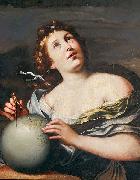 |
Girolamo Troppa -- Click Here
|
|
Girolamo Troppa (1637-1710) was an Italian painter of the Baroque. He was active in Rome. He was a follower of Carlo Maratti. He painted for the church of San Giacomo delle Penitenti, in competition with the son of Giovan Francesco Romanelli. He died in 1710. |
|
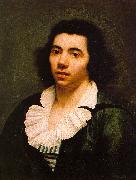 |
Girodet-Trioson, Anne-Louis -- Click Here
|
|
French Neoclassical Painter, 1767-1824
French painter. Originally named Girodet de Roussy or Roucy, he was a student of J.-L. David, and his classical training was sometimes at variance with his often eccentrically romantic expression. He won the Prix de Rome and while in Italy painted the Sleep of Endymion (1791; Louvre), a sensual and erotically ambiguous work that brought him widespread recognition. His Deluge (Louvre) demonstrates Girodet's interest in unusual color and lighting problems. Much of his work, including a series for Malmaison (Napoleon's residence), glorifies Napoleon. |
|
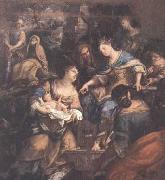 |
Giovanni Tuccari -- Click Here
|
|
Giovanni Tuccari (1667-1743) was an Italian painter during the Baroque period, active in Sicily.
Tuccari was born in Messina. He was the son and pupil of Antonio Tuccari, an obscure painter. He excelled as a battle painter. He died of the plague. He was responsible for the frescos in the Church of San Benedetto in Catania. Other examples of his work include four octagonal paintings in the sanctuary of the Church of S. Antonio, at Castiglione di Sicilia, and La Pinacoteca Zelantea gallery in Acireale.
|
|
 |
Giovanni Toscani -- Click Here
|
|
Italian Painter, ca.1370-1430 |
|
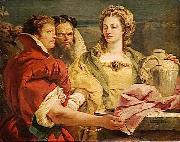 |
Giovanni Domenico Tiepolo -- Click Here
|
|
(August 30, 1727 - March 3, 1804) was a Venetian painter and printmaker in etching. He was the son of artist Giovanni Battista Tiepolo and elder brother of Lorenzo Baldissera Tiepolo..
Domenico was born in Venice, studied under his father, and by the age of 13 was the chief assistant to him. He was one of the many assistants, including Lorenzo, that transferred the designs of his father (executed in the 'oil sketch' invented by the same). By the age of 20, he was producing his own work for commissioners.
He assisted his father in Werzburg 1751-3, decorating the famous stairwell fresco, in Vicenza at the Villa Valmarana in 1757, and in Madrid at the palace of Charles III from 1762-70.
|
|
 |
Giovanni Battista Tiepolo -- Click Here
|
|
Italian Rococo Era Painter, 1696-1770
Giovanni Battista Tiepolo was born in Venice on March 5, 1696. His father, who was part owner of a ship, died when Tiepolo was scarcely a year old, but the family was left in comfortable circumstances. As a youth, he was apprenticed to Gregorio Lazzarini, a mediocre but fashionable painter known for his elaborately theatrical, rather grandiose compositions.
Tiepolo soon evolved a more spirited style of his own. By the time he was 20, he had exhibited his work independently, and won plaudits, at an exhibition held at the church of S. Rocco. The next year he became a member of the Fraglia, or painters guild. In 1719 he married Cecilia Guardi, whose brother Francesco was to become famous as a painter of the Venetian scene. They had nine children, among them Giovanni Domenico and Lorenzo Baldassare, who were also painters.
In the 1720s Tiepolo carried out many large-scale commissions on the northern Italian mainland. Of these the most important is the cycle of Old Testament scenes done for the patriarch of Aquileia, Daniele Dolfin, in the new Archbishop Palace at Udine. Here Tiepolo abandoned the dark hues that had characterized his early style and turned instead to the bright, sparkling colors that were to make him famous. |
|
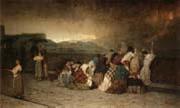 |
Gioacchino Toma -- Click Here
|
|
Italian , Galatina 1836 - Napoli 1891
Italian painter. He was orphaned at the age of six and spent an unhappy childhood and adolescence in convents and poorhouses; these experiences would later provide subjects for his paintings. He was first taught drawing at the art school in the hospice for the poor in the Adriatic town of Giovinazzo, but in 1855 he moved to Naples, where he worked for an ornamental painter named Alessandro Fergola. In 1857 he was mistakenly arrested for conspiracy and exiled to Piedimonte d'Alife, 60 km from Naples, where he was initiated into the secret society of the Carbonari by some local liberal aristocrats who also became his first patrons. His paintings for them were mainly still-lifes, largely in the traditional Neapolitan style. On his return to Naples in 1858 he became a student at the Accademia di Belle Arti, attending the classes of Domenico Morelli, who influenced such early works as Erminia (1859; Naples, Pal. Reale). Toma fought for two years with Garibaldi in the campaign for the unification of Italy, then returned to painting, |
|
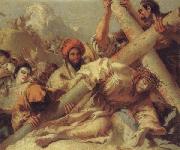 |
Giandomenico Tiepolo -- Click Here
|
|
Italian Rococo Era Painter , Venice 1727 - 1804
was a painter and printmaker in etching, son of artist Giovanni Battista Tiepolo and elder brother of Lorenzo Baldissera Tiepolo. Domenico was born in Venice, studied under his father, and by the age of 13 was the chief assistant to him. He was one of the many assistants, including Lorenzo, that transferred the designs of his father (executed in the 'oil sketch' invented by the same). By the age of 20, he was producing his own work for commissioners. He assisted his father in Werzburg 1751-3, decorating the famous stairwell fresco, in Vicenza at the Villa Valmarana in 1757, |
|
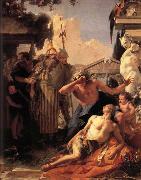 |
Giambattista Tiepolo -- Click Here
|
|
1696-1770
Italian painter, master of Venetian school. Tiepolo was famous in his own lifetime as a superb painter in fresco and a brilliant draftsman. A highly inventive artist, he could create spectacular effects in difficult sites, from the narrow gallery at the patriarchal palace at Udine in the mid-1720s to the vast staircase ceiling in the Residenz at Werzburg in the early 1750s. Contemporaries recognized his spirited, dynamic approach to subject matter and his frankly sensuous manner of painting. Tiepolo is comparable in his restless energy and imaginative power to Peter Paul Rubens, and essentially he worked with a similar baroque language of myth, allegory, and history, which he infused with a sense of freshness and modernity. His approach to religious art is characterized by candor and naturalism, while he was responsive to the different concerns of patrons and viewers at a time when the church was faced with new kinds of devotion and criticism. With the advent of neoclassicism, Tiepolo's art fell from favor: In an age that prized archaeological correctness, rationality, and ideals of improvement, his witty, Veronese-inspired conception of historical or classical subjects seemed frivolous, while his visually seductive qualities were seen as inimical to the serious intellectual aims of the new art. Nevertheless, his drawings and oil sketches continued to appeal to collectors, including Antonio Canova. The son of a Venetian shipping merchant, Tiepolo was apprenticed in 1710 to Gregorio Lazzarini (1655C1730), an artist of international reputation patronized by prominent Venetian families. Before becoming an independent master, he worked in the household of Doge Giovanni Corner; members of the Corner family were to be his most steadfast and liberal patrons. Lazzarini encouraged his pupils to study Venetian sixteenth-century art, and Tiepolo made drawings of some famous works for publication in Domenico Lovisa's Gran Teatro di Venezia of 1717. His early involvement with the thriving Venetian engraving and publishing world was renewed in 1724 when he made drawings of antique sculpture as illustrations for Scipione Maffei's Verona Illustrata, an experience that gave Tiepolo an imaginative empathy with fragmentary antique remains, which recur in his drawings, etchings, and paintings. As well as studying the art of the past, Tiepolo looked to the tenebrism of Federico Bencovich (1677C1753) and the realism and monumentality of Giovanni Battista Piazzetta (1682C1754). In 1719 Tiepolo married Cecilia Guardi, with whom he was to have nine children. By then, the artist was working for a network of mercantile and noble patrons on religious and secular subjects. |
|
|
|
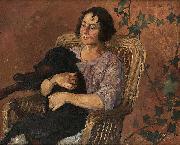 |
Gerda Tiren -- Click Here
|
|
painted Karin and Tippo in 1858-1928 |
|
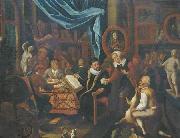 |
Gerard Thomas -- Click Here
|
|
painted The collector of tithes in 1663-1720 |
|
 |
Gerard ter Borch the Younger -- Click Here
|
|
painted Mother Combing the Hair of Her Child. in 1652 |
|
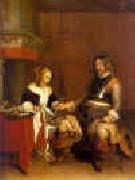 |
Gerard Ter Borch -- Click Here
|
|
1617-1681
Dutch
Gerard Ter Borch Locations
Gerard Ter Borch was born in Zwolle. His first teacher was his father, Gerard Ter Borch the Elder, who in his youth had spent some years in Rome and returned with drawings he had made as well as some he had collected in Italy. The son precociously revealed his gifts as a draftsman, as shown in his drawing of a man on horseback (1625).
Ter Borch traveled widely. In 1634 he was in Haarlem, in 1635 in London, in 1640 probably in Rome. A visit to Spain is reflected in reminiscences of Diego Velazquez in the style and psychological penetration of Ter Borch s portraits. His famous portrait Helena van der Schalke as a Child (ca. 1644) calls to mind Velazquez s Infantas; the placement of the figure in palpable yet undefined space, without the indication of a floor line, is a masterful adoption of the Spanish masters invention.
Between 1645 and 1648 Ter Borch was in Munster, Germany, where he went to seek portrait commissions during the meetings that ended the 80 years of war between the United Provinces and Spain. His small group portrait Swearing of the Oath of Ratification of the Treaty of Munster is a rare example in Dutch 17th-century painting of the recording of an actual historical event. It includes more than 50 recognizable portraits. The painter asked for this work the enormous price of 6, 000 guilders. Apparently no buyer was found, for the picture was in the hands of his widow after his death. From 1654 on Ter Borch lived mainly in Deventer, where he married, became a citizen, held honorary office, and died on Dec. 8, 1681.
Ter Borch s early paintings were mainly scenes of military life, painted with great subtlety of color and values. Later he showed a predilection for small, dainty interior scenes, in which he revealed his delight in the sheen of satin and the grace of charming women. The elegance of his figures has tended to obscure the fact that in many cases they are shown as participants in situations of amatory commerce. The figures and costumes are painted with care and high finish that is not matched in the settings and backgrounds, which are often not well realized. The Music Lesson (ca. 1675) is a characteristic late example of Ter Borchs favorite subject matter. His most able pupil, Caspar Netscher, became a successful portraitist in the small-scale and fashionable tradition of his master. |
|
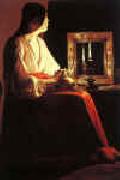 |
Georges de La Tour -- Click Here
|
|
1593-1652
French
Georges de La Tour Galleries
His early work shows influences from Caravaggio, probably via his Dutch followers, and the genre scenes of cheats??as in The Fortune Teller ??and fighting beggars clearly derive from the Dutch Caravaggisti, and probably also his fellow-Lorrainer, Jacques Bellange. These are believed to date from relatively early in his career.
La Tour is best known for the nocturnal light effects which he developed much further than his artistic predecessors had done, and transferred their use in the genre subjects in the paintings of the Dutch Caravaggisti to religious painting in his. Unlike Caravaggio his religious paintings lack dramatic effects. He painted these in a second phase of his style, perhaps beginning in the 1640s, using chiaroscuro, careful geometrical compositions, and very simplified painting of forms. His work moves during his career towards greater simplicity and stillness ?? taking from Caravaggio very different qualities than Jusepe de Ribera and his Tenebrist followers did.
He often painted several variations on the same subjects, and his surviving output is relatively small. His son Etienne was his pupil, and distinguishing between their work in versions of La Tour's compositions is difficult. The version of the Education of the Virgin, in the Frick Collection in New York is an example, as the Museum itself admits. Another group of paintings (example left), of great skill but claimed to be different in style to those of de La Tour, have been attributed to an unknown "Hurdy-gurdy Master". All show older male figures (one group in Malibu includes a female), mostly solitary, either beggars or saints.
After his death in 1652, La Tour's work was largely forgotten until rediscovered by Hermann Voss, a German scholar, in 1915. In 1935 an exhibition in Paris began the revival in interest among a wider public. In the twentieth century a number of his works were identified once more, and forgers tried to help meet the new demand; many aspects of his œuvre remain controversial among art historians. |
|
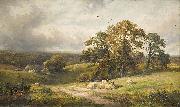 |
George Turner -- Click Here
|
|
1750-1843.
Turner was born in Cromford, Derbyshire in England, but then moved to Derby with his family. He showed an early talent for music and art - encouraged by his father Thomas Turner, who although a tailor by profession was also an art enthusiast. Turner was largely self-taught and went on to become a professional painter and art teacher.
A quiet scene in Derbyshire (1885)Turner lived in Derbyshire all his life. In 1865 he married Eliza Lakin (1837 - 1900), becoming a part-time farmer and raising four children at Walnut farm in Barrow upon Trent.[1] After Eliza's death in 1900, he moved to Kirk Ireton and later married fellow artist Kate Stevens Smith (1871-1964) - they set up home in Idridgehay where he died in 1910. His son William Lakin Turner (1867-1929) also became a landscape oil painter of repute.
Turner worked in oils and painted bucolic scenes mainly of his native Derbyshire, leaving an important legacy of hundreds of pictures depicting the English countryside before the coming of mechanisation, the motor car and urban expansion. His work was exhibited in Nottingham and Birmingham. Turner served on the Art Committee of Derby Art Gallery and both his and his son's paintings are included in the city's collection. |
|
|
|
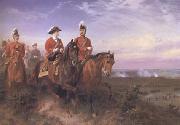 |
George Thomas -- Click Here
|
|
1816-1870
Union general in the American Civil War, b. Southampton co., Va. He served in the Seminole War and in the Mexican War. Later he taught at West Point and served in Texas. As a brigadier general of volunteers, he was sent to Kentucky, where he defeated the Confederates at Mill Springs (Jan., 1862). Thomas served under General Buell at Shiloh, Corinth, and Perryville. In the Chattanooga campaign, his stand on Sept. 20, 1863, which saved the Union army from complete rout, won for him the sobriquet Rock of Chickamauga. Appointed brigadier general in the regular army, he succeeded General Rosecrans in command of the Army of the Cumberland (Oct., 1863) and served under Ulysses S. Grant around Chattanooga and under General Sherman in the Atlanta campaign. With the fall of Atlanta (Sept., 1864), Grant ordered Thomas to pursue the army of General Hood into Tennessee. Although accused by Grant of moving too slowly, and threatened with the loss of his command, Thomas waited and finally defeated Hood at Nashville (Dec., 1864). |
|
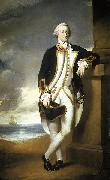 |
George Dance the Younger -- Click Here
|
|
George Dance the Younger (1 April 1741 - 14 January 1825) was an English architect and surveyor. The fifth and youngest son of George Dance the Elder, he came from a distinguished family of architects, artists and dramatists. He was hailed by Sir John Summerson as "among the few really outstanding architects of the century", but few of his buildings remain.
He was educated at the St. Paul's School, London. Aged 17, he was sent to Italy to prepare himself for an architectural career and joined his brother Nathaniel, who was studying painting in Rome. George was a member of academies in Italy, showing much promise as a draughtsman, and much of his later work was inspired by Piranesi, with whom he was acquainted.
He succeeded his father as City of London surveyor and architect on his father's death in 1768, when he was only 27. He had already distinguished himself by designs for Blackfriars Bridge, sent to the 1761 exhibition of the Incorporated Society of Artists.
His earliest London project was the rebuilding of All Hallows-on-the-Wall church in 1767. His first major public works were the rebuilding of Newgate Prison in 1770 and the front of the Guildhall, London. His other London works include the church of St Bartholomew-the-Less (1797). In Bath he largely designed the Theatre Royal, built by John Palmer in 1804-5. Sir John Soane was a pupil.
Many of his buildings have been demolished, including the Royal College of Surgeons, Newgate Prison, St Luke's Hospital for Lunatics, the Shakespeare Gallery in Pall Mall, the library at Lansdowne House, the Common Council Chamber and Chamberlain's Court at the Guildhall, Ashburnham Place, and Stratton Park (demolished save for its Tuscan portico)
With his brother Nathaniel, he was a founder member of the Royal Academy in 1768, and its second professor of architecture, from 1798 to 1805. For a number of years, he was the last survivor of the 40 original Academicians.
|
|
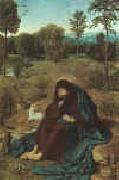 |
Geertgen Tot Sint Jans -- Click Here
|
|
Netherlandish Northern Renaissance Painter, ca.1460-1490
Geertgen tot Sint Jans is also known as Geertgen van Haarlem, Gerrit van Haarlem, or Gerrit Gerritsz.[citation needed] Alternative spellings of his first name are Gheertgen, Geerrit, and Gheerrit, where G(h)eertgen is the diminutive form of G(h)eerrit.
Presumably, he was born in Leiden, then in the Burgundian Netherlands in the Holy Roman Empire, around the year 1465. The assignment of Leiden as his birth place is traceable to a 17th century print by Jacob van Matham. There is no known archival evidence for this claim by Jacob van Matham. The modern acceptance of Leiden as Geertgen's birth place is roughly traceable to Johann Kessler's dissertation of 1930.
Probably, Geertgen was a pupil of Albert van Ouwater, who was one of the first oil painters in the northern Low Countries. Both painters lived in the city of Haarlem. Geertgen was attached to the monastery of the Knights of Saint John, for whom he painted an altarpiece. Although Geertgen was not a member of the Order of Saint John, his last name "tot Sint Jans" was derived from the order's name and means "unto Saint John".
Geertgen died in Haarlem, then the Habsburg Netherlands in the Holy Roman Empire, around the year 1495, when he was approximately 28 years old. He was buried in the monastery of the Knights of Saint John. Modern scholars have attempted to calculate the artist's death date with the information from The Painting-Book (Middle Dutch: Het Schilder-Boeck) by Karel van Mander, published in 1604. There are some archival traces that suggest he may in fact have lived into the 16th century. |
|
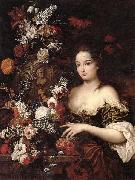 |
Gaspar Peeter Verbrugghen the younger -- Click Here
|
|
Flemish ,
Antwerp 1664-1730
|
|
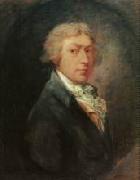 |
GAINSBOROUGH, Thomas -- Click Here
|
|
English Rococo Era/Romantic Painter, 1727-1788
English painter, draughtsman and printmaker. He was the contemporary and rival of Joshua Reynolds, who honoured him on 10 December 1788 with a valedictory Discourse (pubd London, 1789), in which he stated: 'If ever this nation should produce genius sufficient to acquire to us the honourable distinction of an English School, the name of Gainsborough will be transmitted to posterity, in the history of Art, among the very first of that rising name.' He went on to consider Gainsborough's portraits, landscapes and fancy pictures within the Old Master tradition, against which, in his view, modern painting had always to match itself. Reynolds was acknowledging a general opinion that Gainsborough was one of the most significant painters of their generation. Less ambitious than Reynolds in his portraits, he nevertheless painted with elegance and virtuosity. He founded his landscape manner largely on the study of northern European artists and developed a very beautiful and often poignant imagery of the British countryside. By the mid-1760s he was making formal allusions to a wide range of previous art, from Rubens and Watteau to, eventually, Claude and Titian. He was as various in his drawings and was among the first to take up the new printmaking techniques of aquatint and soft-ground etching. Because his friend, the musician and painter William Jackson (1730-1803), claimed that Gainsborough detested reading, there has been a tendency to deny him any literacy. He was, nevertheless, as his surviving letters show, verbally adept, extremely witty and highly cultured. He loved music and performed well. He was a person of rapidly changing moods, humorous, brilliant and witty. At the time of his death he was expanding the range of his art, having lived through one of the more complex and creative phases in the history of British painting. He painted with unmatched skill and bravura; while giving the impression of a kind of holy innocence, he was among the most artistically learned and sophisticated painters of his generation. It has been usual to consider his career in terms of the rivalry with Reynolds that was acknowledged by their contemporaries; while Reynolds maintained an intellectual and academic ideal of art, Gainsborough grounded his imagery on contemporary life, maintaining an aesthetic outlook previously given its most powerful expression by William Hogarth. |
|
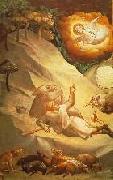 |
GADDI, Taddeo -- Click Here
|
|
Italian Early Renaissance Painter, ca.1300-1366
Italian painter active in Florence. He was the son of a painter and mosaicist and a student of Giotto. His best-known works are frescoes in the church of Santa Croce in Florence. He directed a flourishing workshop for three decades, producing pictures in the style of Giotto but featuring more vivid picturesque effects with narrative detail. His son and pupil Agnolo (c. 1350 C 96) was an influential and prolific artist who likewise produced a notable series of frescoes for Santa Croce, The Legend of the True Cross |
|
|
|
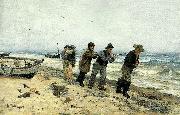 |
fritz thaulow -- Click Here
|
|
född 1847 i Christiania, död 5 november 1906, var en norsk målare. Han är en av de internationellt mest kända norska konstnärerna från 1800-talet.
Thaulow fick sin utbildning vid Konstakademin i Köpenhamn 1870 -72, och 1873-75 var han elev till Hans Gude i Karlsruhe. Åren efter detta uppehöll han sig för det mesta i Paris där han fick avgörande intryck från de franska impressionisterna.
1880 vände Thaulow hem som överbevisad naturalist. Tillsammans med Christian Krohg och Erik Werenskiold blev han snabbt en av ledarna i de unge konstnärernas kamp för en rikare och mer vidsynt norsk konstmiljö. Thaulow var bl.a. med på att etablera den första Höstutställningen 1882.
1892 slog han sig ner i Frankrike, och han besökte USA 1898. Från och med samma år bosatte han sig i Paris, där han blev en kändis och blev också känd internationellt, bl.a. genom att bli antagen till den prestigefulla Salongen. |
|
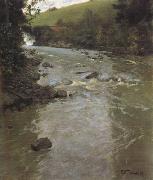 |
Frits Thaulow -- Click Here
|
|
Norwegian Impressionist Painter, 1847-1906
.Norwegian painter and engraver. Originally wanting to become a marine painter he studied at the art academy in Copenhagen (1870-73) as well as with the Danish marine specialist C. F. S?rensen (1818-79). He spent two winters at Karlsruhe (1873-4, 1874-5) as the pupil of Hans Gude and then went to Paris, where he spent much of the period 1875-9. His marines and coastal pictures, some of which were accepted at the Paris Salon, were only moderately successful, but he acquired a fair knowledge of contemporary French Realist art and felt that Norwegian artists should learn from it. |
|
|
|
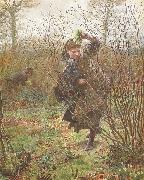 |
Frederick Walker,ARA,RWS -- Click Here
|
|
1840-1875
English painter and illustrator. He acquired his training in drawing and painting through study in the British Museum (where he copied heavily from the Antique), a short period spent in an architect's office, life classes at Leigh's school, a studentship at the Royal Academy and three years' employment as a draughtsman on wood with the commercial engraver Josiah Wood Whymper (1813-1903). |
|
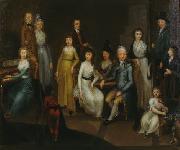 |
Franz Thomas Low -- Click Here
|
|
Lived in 18th centry. |
|
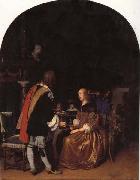 |
Frans van mieris the elder -- Click Here
|
|
Dutch Baroque Era Painter, 1635-1681
was a Dutch genre and portrait painter. The leading member of a Leiden family of painters, his sons Jan (1660-1690) and Willem (1662 C1747) and his grandson Frans van Mieris the Younger (1689 C1763) were also accomplished genre painters. Frans was the son of Jan Bastiaans van Mieris, a goldsmith, carver of rubies and diamond setter at Leiden. His father wished to train him to his own business, but Frans preferred drawing, and took service with Abraham Torenvliet, a glazier who kept a school of design. In his father's shop he became familiar with the ways and dress of people of distinction. His eye was fascinated in turn by the sheen of jewelry and stained glass; and, though he soon gave up the teaching of Torenvliet for that of Gerard Dou and Abraham van den Tempel, he acquired a manner which had more of the finish of the exquisites of the Dutch school than of the breadth of the disciples of Rembrandt. It should be borne in mind that he seldom chose panels of which the size exceeded 12 to 15 inches, and whenever his name is attached to a picture above that size we may surely assign it to his son Willem or to some other imitator. Unlike Dou when he first left Rembrandt, or Jan Steen when he started on an independent career, Mieris never ventured to design figures as large as life. Characteristic of his art in its minute proportions is a shiny brightness and metallic polish. The Music Lesson,National Museum of Serbia , BelgradeThe subjects which he treated best are those in which he illustrated the habits or actions of the wealthier classes; but he sometimes succeeded in homely incidents and in portrait, and not unfrequently he ventured on allegory. He repeatedly painted the satin skirt which Ter Borch brought into fashion, and he often rivalled Ter Borch in the faithful rendering of rich and highly-coloured woven tissues. But he remained below Ter Borch and Metsu, because he had not their delicate perception of harmony or their charming mellowness of touch and tint, and he fell behind Gerard Dou, because he was hard and had not his feeling for effect by concentrated light and shade. In the form of his composition, which sometimes represents the framework of a window enlivened with greenery, and adorned with bas-reliefs within which figures are seen to the waist, his model is certainly Dou. |
|
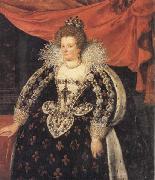 |
Frans Pourbus the younger -- Click Here
|
|
Flemish Baroque Era Painter, 1569-1622
was a Flemish painter, son of Frans Pourbus the Elder and grandson of Pieter Pourbus. He was born in Antwerp and died in Paris. He is also referred to as "Frans II". Pourbus worked for many of the highly influential people of his day, including the Brussels-based Spanish Regents of the Netherlands, the Duke of Mantua and Marie de' Medici, Queen of France. Works of his can be found in the Louvre, the Prado, the Rijksmuseum, the Royal College of Art, the Metropolitan Museum of Art and many other museums. |
|
|
|
Frank Walton -- Click Here
|
|
Frank Walton. RI, RBA (1840 - 1888) |
|
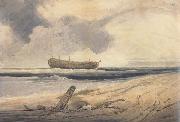 |
Francois Louis Thomas Francia -- Click Here
|
|
French, 1772-1839
was a French painter born in Calais and famous for his shore landscapes. He was the master of the young British painter Richard Parkes Bonington. This article about a French painter is a stub. |
|
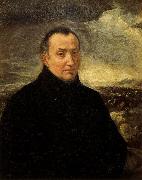 |
Francois de Troy -- Click Here
|
|
French Baroque Era Painter, 1645-1730
was a French painter and engraver who became principal painter to King James II in exile at Saint-Germain-en-Laye and Director of the Academie Royale de peinture et de sculpture. One of a family of artists, Troy was born in Toulouse, the son of Nicolas de Troy (1608 - 15 September 1684), a painter in that city,and was the brother of Jean de Troy (4 April 1638 - 25 June 1691).Troy was taught the basic skills of painting by his father, and perhaps also by the more worldly Antoine Durand. François de Troy is not to be confused with his son, the portrait painter Jean-François de Troy (1679-1752), who studied under him At some time after 1662, Troy went to Paris to study portrait painting under Claude Lefebvre (1633-1675) and Nicolas-Pierre Loir (1624 - C1679]. A. P. F. Robert-Dumesnil states that this occurred when Troy was aged twenty-four. In 1669, Troy married his master Nicolas-Pierre Loir's sister-in-law, Jeanne Cotelle. In 1671, he was approved by the Academie Royale de peinture et de sculpture. In 1674, he was received into the Academy as a history painter, with a reception piece (morceau de reception) entitled Mercure coupant la tete d'Argus ('Mercury cutting off the head of Argus'). Troy's early known works include tapestry designs for Madame de Montespan, one of the many mistresses of Louis XIV of France, and paintings with religious and mythological subjects. In the 1670s, he became friendly with Roger de Piles, who introduced him to Dutch and Flemish painting, |
|
|
|
|
| | |
|
|
|
|